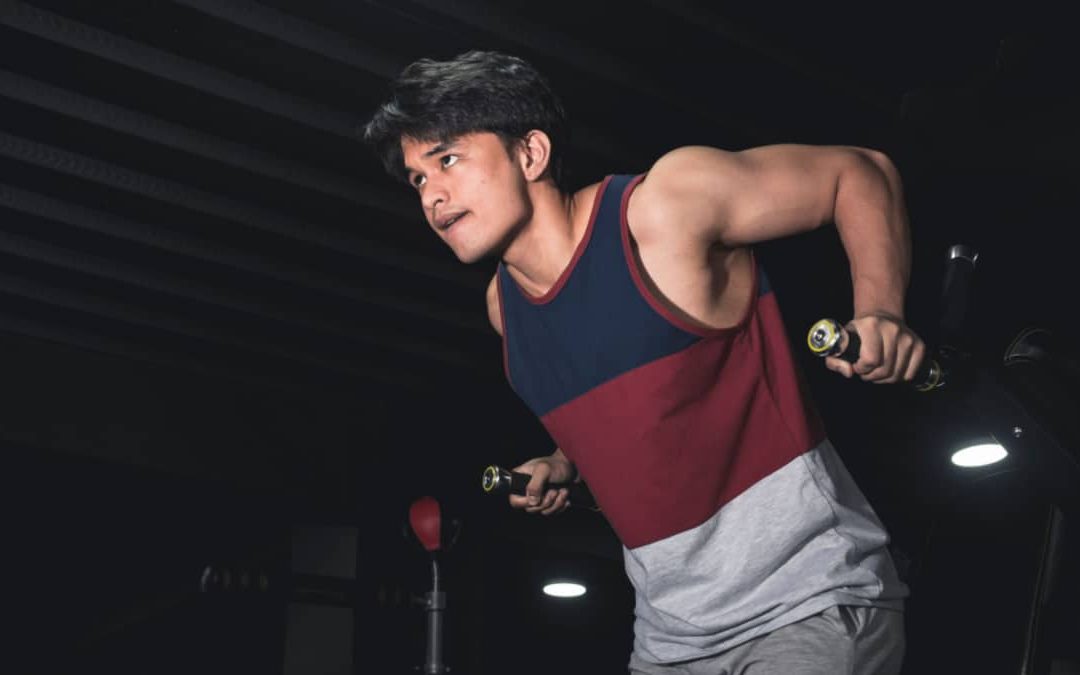For some lifters, nothing beats the upper-body pump they get from a high-intensity chest workout. Many of these gym-goers hope to build a bigger, stronger chest by focusing on the bench press, but mastering the simple and effective bodyweight dip often goes overlooked.

This staple movement isn’t just for gymnasts or calisthenics enthusiasts. It’s a fundamental old school exercise that’s been used by bodybuilders and strength athletes for decades.
Adding dips to your workout routine will target your pecs, triceps, and shoulders for an all-around bigger, fuller, stronger upper body. Here’s how to use only your body weight to deliver a deep burn and explosive pump for your chest.
- How to Do Dips
- Dip Mistakes to Avoid
- Benefits of Dips
- Muscles Worked by Dips
- Who Should Do Dips
- How to Program Dips
- Dip Variations
- Dip Alternatives
- Frequently Asked Questions
How to Do Dips
Dips can be done on dedicated dip bars, at an assisted dip station, or a sturdy and stable pair of chairs. Whichever setup you’re using, ensure it’s at a height where you can keep your legs and feet off the ground when in the bottom (stretched) position. This will allow a full range of motion for maximum benefit.
Step 1 — Get up on the Bars

Step up to the dip station and grab the bars with palms your facing inward. Keep your arms straight — depending on the setup, you may need to sightly jump into the locked out position. Bend your legs slightly so that your arms support your entire body weight.
Keep your back straight and your head looking forward. Engage your core and glutes by squeezing them both to keep your entire body tight.
Form tip: Ideally, your hands should be roughly shoulder-width distance. Some dip bars are angled to allow different grip widths. If your hands are farther apart, shoulder-joint strain can increase and tension on your chest muscles can decrease.
Step 2 — Lower into a Stretch

Slowly lower your body until your elbows are roughly at 90-degree angles, if your mobility allows. Maintain a forward-looking head position, but let your upper body angle slightly forward to increase recruitment of the chest muscles.
Your elbows will naturally angle slightly outwards. Avoid excessively flaring your elbows directly to the sides, which can increase strain on the shoulder joints.
Form tip: Use a slow tempo to ensure control, maximum muscle tension, and boost muscle growth. (1) Take up to three seconds to reach the bottom position.
Step 3 — Drive up to Full Contraction

Push your body up in a controlled, fluid motion. Stop once you’re back at the starting position with nearly straight arms. Briefly pause at the top to stabilize your body and minimize any swinging.
As your body rises, focus on feeling constant tension contracting your chest muscles. Engage the mind-muscle connection by focusing your full attention on the pecs and visualize the muscle fibers working.
Form tip: Your body’s path upwards should mirror the lowering phase. Your head and shoulders should arc slightly in front of your hands on the way down, and your upper body should return to a fully stacked position with your elbows above your wrists.
Dip Mistakes to Avoid
Dips are a classic bodyweight exercise that can add strength and size to your chest, arms, and shoulders. However, poor form can lead to suboptimal results or potential injury, including wear and tear on your rotator cuff tendons. (2) Fortunately, the most common errors are relatively easy to avoid.
Locking Your Elbows
In the top position, avoid locking your elbows ramrod straight. Maintain a slight bend in your arms to keep them under constant tension and yield optimal muscle-building results. (3) Paying attention to your arm position at lockout reinforces using a relatively slow tempo while focusing on maximum muscle recruitment.
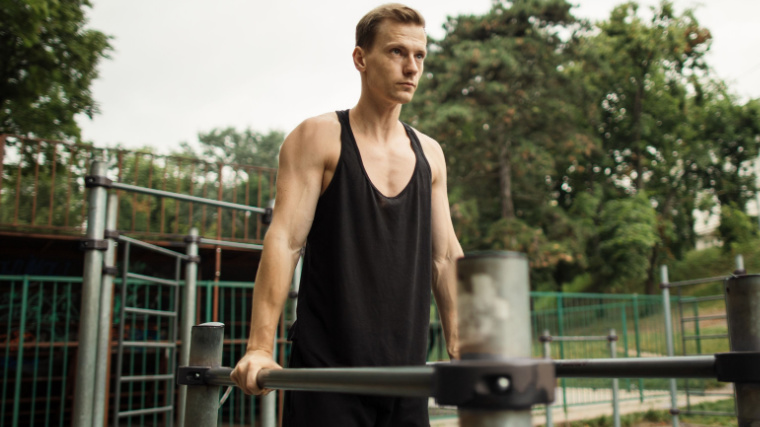
In addition, locking your elbows puts them in a potentially hyperextended state, which may increase your risk of injury.
Avoid it: As your body approaches the top of the movement, pay attention not only to your chest muscles contracting, but your arm position. This will be difficult to do if you use sloppy, swinging repetitions, so maintain a constant, fluid motion throughout each repetition.
Dipping Too Low
The bottom, stretched position of most exercises is where the involved joints are under the greatest potential stress. Save your shoulders by paying close attention your depth when doing dips.
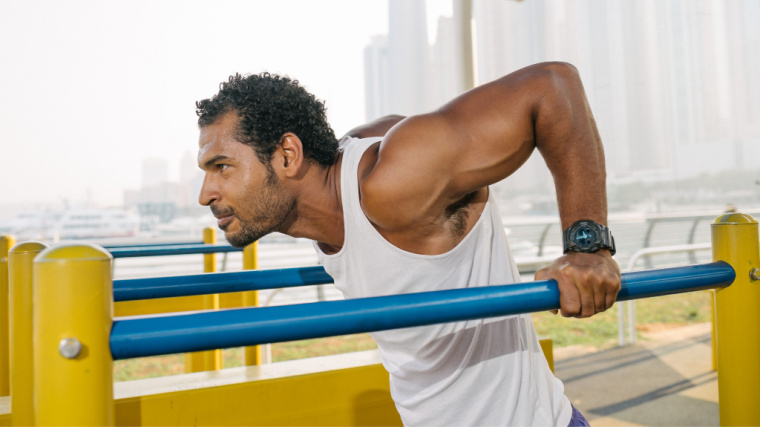
Going too low, beyond the point where you feel your shoulder muscles stretching, can significantly strain the joints. Remember, form is king when it comes to any exercise. Bodyweight exercises, including dips, are no different.
Avoid it: As you lower your body into the stretched position, you should feel both your chest muscles and shoulder muscles stretching. Don’t let your ego talk you into using an excessive range of motion. If you can see a mirror during the exercise, pay extra attention as your elbows approach a 90-degree bend. Stopping slightly higher is more acceptable than dropping too low.
Benefits of Dips
This basic bodyweight exercise allows you to build muscle mass and strength in your upper body, particularly your chest, shoulders, and triceps. Mastering strength training exercise with your bodyweight can also help to reduced your overall risk of injury and improve core stabilization.
Increased Muscle Mass and Strength
Doing dips stimulates your pecs, triceps, and core significantly. By stretching and creating tension on the entire chest muscle, dips are an efficient exercise for boosting muscle growth. (4) Bodyweight exercises have also been shown to be comparable to free weight exercises for building strength. (5)
Improved Joint Health
Maintaining muscular balance is essential for joint stability and overall health and performance, and bodyweight training is a highly effective solution. (6)
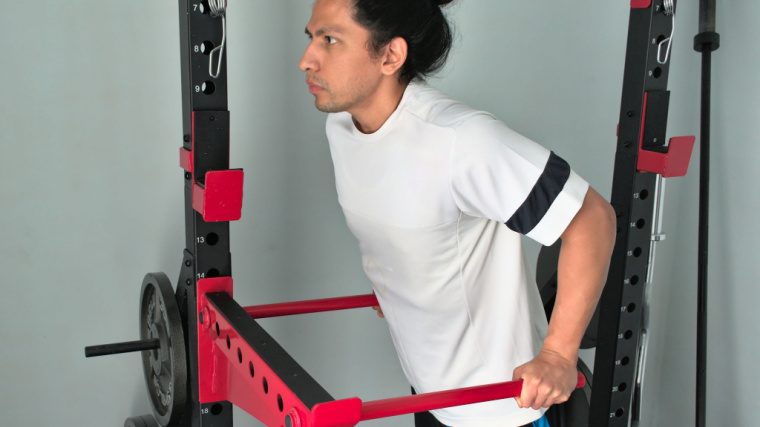
If you perform many pulling exercises or participate in activities that are pulling-intensive (e.g. training on rowing machines, pull-ups, many combat sports, etc.), regularly performing dips can build strong pushing muscles to help prevent muscular imbalances. A 10% increase in strength training volume has shown to substantially minimize overall injury risk. (7)
Improved Core Stabilization
Dips aren’t solely a chest exercise. You’ll engage your core by keeping your lower body stable throughout the movement. While your core isn’t directly trained during dips, it is strongly recruited to provide total-body stability and coordinated movement as you press. Improved core stability helps to promote overall strength, health, and injury prevention. (8)
Muscles Worked by Dips
Dips are a highly effective exercise for strengthening the muscles located in and around the chest. While dips primarily target the chest itself, the triceps and shoulders are also directly trained, as well as smaller stabilizers throughout the upper body.
Pectoralis Major
The pectoralis major is a thick, fan-shaped muscle that’s the largest muscle of the front chest wall. The pecs have multiple functions controlling arm movement including flexion and adduction (bringing the arms toward the body’s centerline)(9)
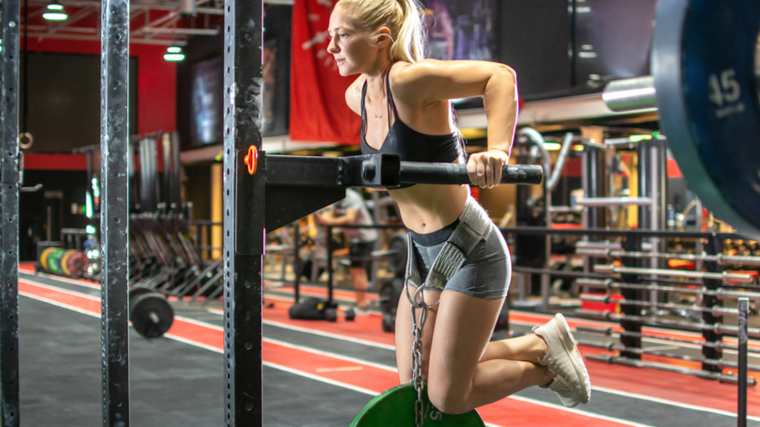
The pec major has two heads, the clavicular (upper chest) and the sternocostal (mid and lower chest). When executing dips, the clavicular head is more significantly worked as you approach the top portion of the movement. The sternocostal head is more highly activated as you lower into the stretched position. (9)
Triceps Brachii
The triceps consist of three separate but functionally similar muscle heads — the long, medial, and lateral. These are found on the back of the upper arm. The triceps are responsible for straightening the arm at the elbow joint, extending the shoulder, and moving the arm behind the torso — all of which work in sync during dips. (10)
Dips apply tension on all three heads of the triceps. Interestingly, the medial head, in particular, is more activated when the elbow is flexed beyond 90-degrees and the body reaches a relatively significant depth. (10)
Anterior Deltoid
The anterior deltoid (front shoulder muscles) is involved when raising the arm forward, in line with your body. More particularly, it’s engaged when moving your arm from behind your body to the front and/or overhead. During dips, the anterior deltoid is activated when your upper arm moves from the 90-degree bent position into the top position with your arms straight arms by your sides.
The anterior deltoids shoulder not be the primary working muscle during dips, but they are recruited significantly, which is why lifters with pre-existing shoulder problems may not be comfortable performing the exercise.
Abdominals
The abs are worked statically to control your lower body and maintain a stable total-body position. Similar to performing pull-ups, it’s not uncommon for lifters to feel some ab tension (or even post-workout soreness) in their abs after several intense sets of dips.
While your abs aren’t contracting through a significant range of motion, they are recruited to maintain control over the hips and pelvis, and prevent any leg swinging.
Who Should Do Dips
Whether you’re pushing a lawnmower or pushing a weight overhead, having adequate upper body pressing strength is essential. Dips can help to increase muscle mass, improve functional strength, and build greater upper body mobility.
Bodybuilders and Physique Athletes
Dips are a bodyweight-only alternative to the bench press or other chest pressing exercises. It allows lifters to train the chest with high tension, high intensity, and minimum equipment. Dips can help to sculpt the chest by working the pecs at a unique angle, creating an effective stimulus for growth. (11)
Strength Athletes
Any lifter focused on moving maximum weight in a pressing movement (bench press, overhead press, clean & jerk, etc.) can benefit from adding dips to their accessory training. By building the chest, shoulders, and triceps, you can improve the potential power and strength those muscle can exert. (12) The bodyweight dip also allows an intense workout with relatively less load, which can reduce cumulative stress on the joints.
How to Program Dips
Most beginners will find the dip to be challenging because you’re required to lift the majority of their own body weight, which can be too difficult due to lack of strength. Fortunately, persistence and effort will yield improvement. Experienced lifters can also benefit from the exercise as a training staple for size and strength.
Unweighted, Moderate Volume (Sets and Reps)
When chasing optimal muscle gains, training the bodyweight dip with four to six sets of 12 to 15 reps, once or twice a week can be highly effective. Approach failure on the final reps of each set to ensure appropriate intensity. This total volume provides your chest with sufficient time under tension to trigger muscle growth.
Weighted or Unweighted, Low Repetition
Performing low volume with low repetitions, such as four to five sets of three to six reps, is a reliable method to build strength. This low volume can be achieved by suspending weight from a belt, holding a dumbbell between your feet, or from simply being unable to perform more than six repetitions with good form.
Performing unweighted, low repetition sets frequently throughout the day is one effective method for building strength and improving technique. This is known as greasing the groove and it’s a highly effective way to master any bodyweight exercise, including dips.
Dip Variations
Dips can be used by lifters and athletes of any fitness level to apply tension to the multiple heads of the chest, triceps, and delts. Begin with more manageable versions of the dips while focusing on form, then add intensity and volume as you progress.
Ring Dip
Ring dips are a more challenging variation that requires significant muscular coordination, balance, and stability. This exercise applies tension to the pecs through a long range of motion while also challenging the smaller stabilizers in the shoulders and upper back.
Ring dips are a popular exercise in CrossFit programming, as well as general gymnastic-based programs, but the increased recruitment of the upper body stabilizers can help to improve muscular coordination and overall shoulder health when programmed appropriately.
Triceps Dip
This very subtle variation uses slight adjustments to your arm and torso positions. These will decrease emphasis on the chest and increase recruitment of the triceps, making it a popular and efficient arm-building movement.
The first significant difference from the chest-focused dip is to maintain an upright torso during the descent rather than leaning forward, to reduce recruitment of the chest muscles. Even more importantly, keep your elbows near your body and aimed towards the wall behind you. (13) Don’t allow them to flare outwards.
Dip Alternatives
If a lack of shoulder mobility or pre-existing injury prevents you from executing dips, there are plenty of alternative exercises you can do to continue adding size and strength to your chest.
Push-up
Good ol’ push-ups. This classic exercise is an excellent alternative to dips that still uses your own bodyweight to apply tension to the pecs and pressing muscles.
Some experienced lifters consider push-ups to be too easy but, like dips, push-ups can be progressed with increased volume or external load to consistently challenge the muscles. The chest and shoulder muscles aren’t put through a significant stretch during push-ups, compared to dips, making them an ideal option for lifters with pre-existing joint pain.
Bench Press
The classic bench press is an excellent substitute for dips because the potential to move heavy weights can carryover to size and strength gains. Some gym veterans would rank the bench press on par with dips as fundamental chest-building exercises.
The flat barbell bench press is obviously essential for powerlifters, as one of the competitive lifts. Its potential to build upper-body strength can also carryover to other strength athletes including strongmen and strongwomen.
FAQs
Are dips bad for the shoulders?
Using proper form and avoiding the technique mistakes explained above, dips will place more stress on the pecs, triceps, and anterior deltoid muscles instead of the associated joints. This optimal muscle recruitment can significantly reduce the risk of injury.
However, if the exercise is executed with improper form or too heavy a load, dips may lead to shoulder impingement, potentially straining the rotator cuff tendons. (14) Fundamentally, the principles which apply to all exercises apply to dips — do them properly, with programming appropriate for your fitness level, and you’ll minimize potential hazards.
How should I program dips with other presses in a chest workout?
Specific programming variables will depend on a number of factors, including your experience level, training frequency, and goals. Generally speaking, performing one to three various types of presses in a single workout can be an effective way to train your chest.
Ideally, the exercises will be diverse — such as the flat barbell bench press, dips, and incline dumbbell press. Redundant training — such performing the flat barbell bench press, flat dumbbell bench press, and close-grip barbell bench press in one session— will deliver excessive fatigue and minimal results.
Time to Take a Dip
Shoulder injuries, poor shoulder mobility, and lack of “pushing strength” can interfere with daily life and hinder performance in the gym, on the platform, and on the field. However, incorporating dips into your training program can pack on muscle, increase strength, reduce injury risk, and enhance physical performance for lifters, athletes, and weekend warriors alike.
References
- Wilk, M., Zajac, A., Tufano, J.J. The Influence of Movement Tempo During Resistance Training on Muscular Strength and Hypertrophy Responses: A Review. Sports Med 51, 1629–1650 (2021). doi: 10.1007/s40279-021-01465-2
- Mckenzie, Alec & Crowley-McHattan, Zachary & Meir, Rudi & Whitting, John & Volschenk, Wynand. (2021). Glenohumeral Extension and the Dip: Considerations for the Strength and Conditioning Professional. Strength and Conditioning Journal. 43. 93-100. 10.1519/SSC.0000000000000579.
-
Burd NA, Andrews RJ, West DW, Little JP, Cochran AJ, Hector AJ, Cashaback JG, Gibala MJ, Potvin JR, Baker SK, Phillips SM. Muscle time under tension during resistance exercise stimulates differential muscle protein sub-fractional synthetic responses in men. J Physiol. 2012 Jan 15;590(2):351-62. doi: 10.1113/jphysiol.2011.221200. Epub 2011 Nov 21. PMID: 22106173; PMCID: PMC3285070.
-
Krzysztofik, M., Wilk, M., Wojdała, G., & Gołaś, A. (2019). Maximizing Muscle Hypertrophy: A Systematic Review of Advanced Resistance Training Techniques and Methods. International journal of environmental research and public health, 16(24), 4897. https://doi.org/10.3390/ijerph16244897
-
Calatayud, J., Borreani, S., Colado, J. C., Martin, F., Tella, V., & Andersen, L. L. (2015). Bench press and push-up at comparable levels of muscle activity results in similar strength gains. Journal of strength and conditioning research, 29(1), 246–253. https://doi.org/10.1519/JSC.0000000000000589
- Harrison, Jeffrey. (2010). Bodyweight Training: A Return To Basics. Strength & Conditioning Journal. 32. 52-55. 10.1519/SSC.0b013e3181d5575c.
- Lauersen, J.B., Andersen, T.E., Andersen, L.B. Strength training as superior, dose-dependent and safe prevention of acute and overuse sports injuries: a systematic review, qualitative analysis and meta-analysis. Br J Sports Med. 2018 Dec;52(24):1557-1563. doi: 10.1136/bjsports-2018-099078.
- Huxel Bliven, K.C., Anderson, B.E. Core stability training for injury prevention. Sports Health. 2013 Nov;5(6):514-22. doi: 10.1177/1941738113481200.
- National Institutes of Health: Stat Pearls. Anatomy, Thorax, Pectoralis Major Major.
- Landin, D., Thompson, M., Jackson, M. Functions of the Triceps Brachii in Humans: A Review. J Clin Med Res. 2018 Apr;10(4):290-293. doi: 10.14740/jocmr3340w.
-
Baz-Valle, E., Schoenfeld, B. J., Torres-Unda, J., Santos-Concejero, J., & Balsalobre-Fernández, C. (2019). The effects of exercise variation in muscle thickness, maximal strength and motivation in resistance trained men. PloS one, 14(12), e0226989. https://doi.org/10.1371/journal.pone.0226989
-
Reggiani, C., & Schiaffino, S. (2020). Muscle hypertrophy and muscle strength: dependent or independent variables? A provocative review. European journal of translational myology, 30(3), 9311. https://doi.org/10.4081/ejtm.2020.9311
- Cinarli, Fahri & Kafkas, Muhammed & Soylu, Abdullah & Yılmaz, Nurkan. (2021). EFFECT OF ELBOW ANGLE ON TRICEPS BRACHII AND PECTORALIS MAJOR MUSCLE ACTIVITY DURING PARALLEL BAR DIP. 27. 57-69.
-
Escamilla, R. F., Hooks, T. R., & Wilk, K. E. (2014). Optimal management of shoulder impingement syndrome. Open access journal of sports medicine, 5, 13–24. https://doi.org/10.2147/OAJSM.S36646
Featured Image: MDV Edwards / Shutterstock

